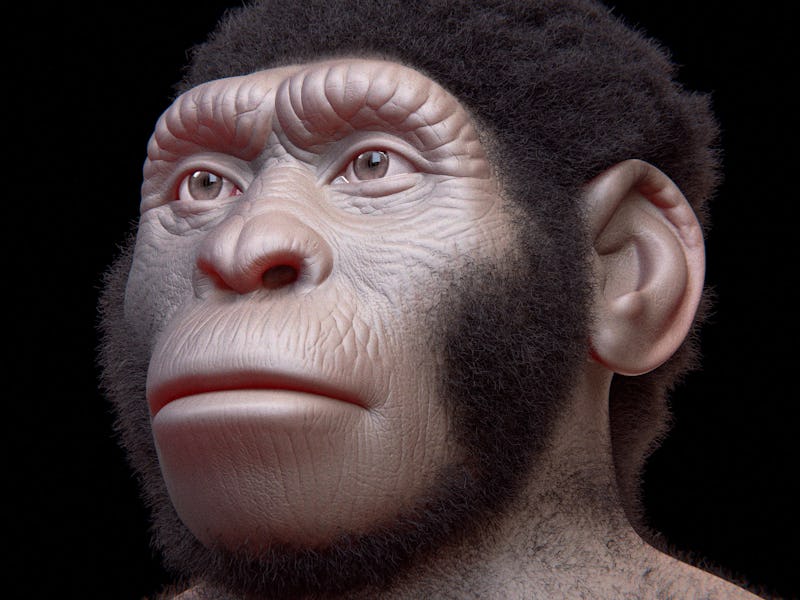This Ape-Man Lived Alongside Early Humans
So much for that tidy theory.

In late 2015, the world first met Homo naledi, a newly discovered human-like species that was found deep within a South African cave.
On Tuesday, a follow-up study dating the bones was published in eLIFE, and the results were nothing short of astounding. Dating showed that the fossils were in fact much more recent than previously estimated. At between 236,000 and 335,000 years old, these primitive looking hominins would have coexisted with modern humans in Africa, complicating the story of who we are and where we came from.
Homo naledi attracted attention because it had some ape-like aspects combined with more human features. The species had a small brain, flat midface, and curved fingers — like a chimpanzee — but also teeth, thumbs, wrists, and feet that look very much like our own.
But, judging by their age, these were not some halfway point in evolutionary history between apes and modern humans. Instead, they must have co-existed with our ancestors in Africa for a long time. Previously it was assumed that modern humans emerged and quickly replaced closely related species on the continent. If that’s not true, then a lot of what we thought we knew about hominins in Africa at that time is in question.
These 'Homo naledi' bones were recovered from a cave in South Africa.
“We can no longer assume that we know which species made which tools, or even assume that it was modern humans that were the innovators of some of these critical technological and behavioural breakthroughs in the archaeological record of Africa,” says Lee Berger of the University of the Witwatersrand, who led the research. “If there is one other species out there that shared the world with modern humans in Africa, it is very likely there are others. We just need to find them.”
The scientists suspect that Homo naledi — small brains notwithstanding — buried their dead, a trait thought to have been exclusive to humans. There’s no better explanation for why fossils from so many individuals would be found in a cave with openings well under a foot to squeeze through. A second cave in the area has also been discovered with the exact same pattern — remains of multiple individuals in a tight spot.
If there’s anything that Homo naledi teaches us, it’s not to assume that the story of humans will fit neatly with the available evidence. We should not be surprised when a new fossil discovery blows open all expectations of what came before, rather than filling in a known gap in understanding.
How much evidence is still out there — and what we could learn from it — is an open question. And it’s one that can only be answered by going out and exploring.
Abstract
New ages for flowstone, sediments and fossil bones from the Dinaledi Chamber are presented. We combined optically stimulated luminescence dating of sediments with U-Th and palaeomagnetic analyses of flowstones to establish that all sediments containing Homo naledi fossils can be allocated to a single stratigraphic entity (sub-unit 3b), interpreted to be deposited between 236 ka and 414 ka. This result has been confirmed independently by dating three H. naledi teeth with combined U-series and electron spin resonance (US-ESR) dating. Two dating scenarios for the fossils were tested by varying the assumed levels of 222Rn loss in the encasing sediments: a maximum age scenario provides an average age for the two least altered fossil teeth of 253 +82/–70 ka, whilst a minimum age scenario yields an average age of 200 +70/–61 ka. We consider the maximum age scenario to more closely reflect conditions in the cave, and therefore, the true age of the fossils. By combining the US-ESR maximum age estimate obtained from the teeth, with the U-Th age for the oldest flowstone overlying Homo naledi fossils, we have constrained the depositional age of Homo naledi to a period between 236 ka and 335 ka. These age results demonstrate that a morphologically primitive hominin, Homo naledi, survived into the later parts of the Pleistocene in Africa, and indicate a much younger age for the Homo naledi fossils than have previously been hypothesized based on their morphology.